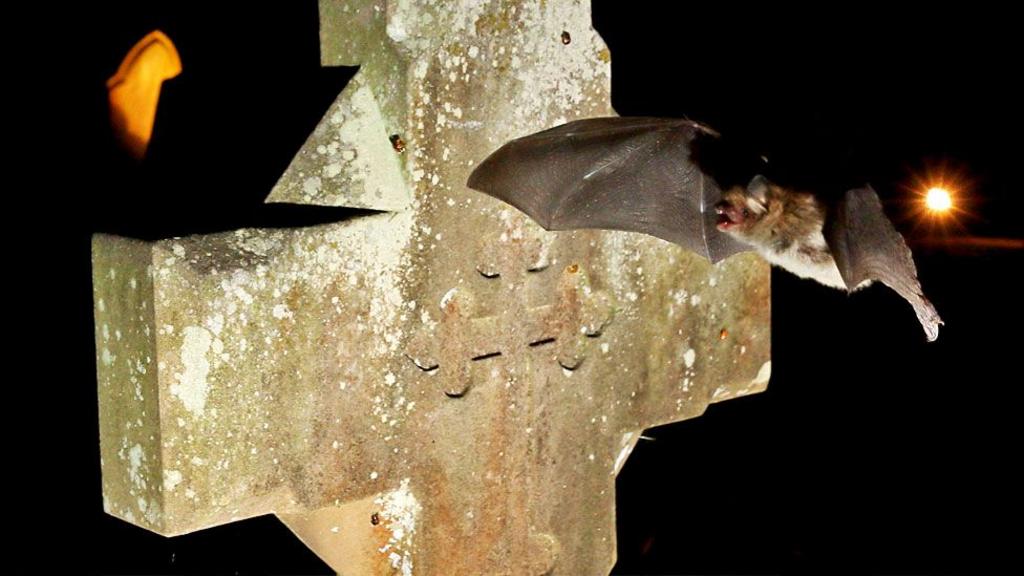It’s a task often relegated to the shadows.
As dusk descends, bat researchers navigate the ancient gravestones of Guestwick Church in Norfolk.
With a creak, the church door opens, revealing a pitch-black, vacant interior, and the team commences the setup of their specialized equipment.
Infrared and thermal cameras are strategically positioned, while audio detectors are calibrated to the specific frequencies of bat vocalizations.
Soon, the bats emerge, gracefully darting and swooping through the aisles, their amplified chatter reverberating within the historic edifice.
“Many of these churches have occupied these sites for potentially 1,000 years, and it’s likely that bats have been residing within them for just as long,” notes Diana Spencer of the Bats in Churches Project.
A recent study, featured in the British Ecological Society’s People & Nature journal, highlights the crucial role these historical structures play as habitats for these nocturnal creatures.
The research, drawing upon citizen science surveys conducted by the Bat Conservation Trust, suggests that approximately half of all churches in England – exceeding 8,000 – serve as bat roosts.
This figure escalates to around 80% for older church buildings.
“They essentially function as man-made forests,” Spencer explains.
“Abundant with concealed nooks and crannies suitable for roosting, expansive open spaces for flight, and dry, sheltered interiors, they offer an ideal environment.”
Guestwick Church hosts two bat species: Common Pipistrelles and Natterer’s bats, which typically roost high within the rafters.
The Pipistrelles emerge first, circling for a short duration before squeezing through minuscule openings around the church door.
The Natterer’s bats follow, preferring to exit through small roof apertures to forage for food outside.
Without specialized camera equipment, spotting these bats in the darkness proves nearly impossible.
The study revealed that approximately one-third of the surveyed churches were unaware of their bat inhabitants.
However, in other locations, the bats’ presence was far more conspicuous, as they can sometimes be untidy occupants.
“They are indeed charming, but they also present challenges,” remarks Graeme Peart from St Margaret’s Church in Saxlingham, located near Guestwick.
He is responsible for the church’s maintenance and notes that the bats began causing issues roughly 15 years ago.
“The urine and droppings are problematic,” he explains. “On one occasion, a carpet leading to the altar was saturated with urine and droppings, necessitating its removal. They also caused damage to the brass fixtures.”
Bats are legally protected in the UK, generally precluding their removal.
However, the church collaborated with the Bats in Churches team to devise a solution, constructing a sealed-off loft conversion above the vestry.
Ecologist Phillip Parker sets up his ladder to provide a glimpse inside.
“The intention is for the bats residing in the main church area to relocate here,” he clarifies.
The loft is equipped with CCTV cameras, facilitating the team’s monitoring of the animals’ behavior.
“We’ve observed that during certain weeks, the loft hosts up to a hundred bats, only for them to suddenly vanish,” Parker notes.
“We remain uncertain of their destination, but they typically return after approximately 10 days. This behavior would have remained unknown without the CCTV system.”
Major construction projects like this require significant time, effort, and funding.
The new loft and ongoing bat monitoring have incurred costs of roughly £50,000, financed by the Heritage Lottery Fund and other partners.
Diana Spencer indicates that less costly solutions are available, and grants are offered by the Bat Conservation Trust.
“At a basic level, sheets or covers can be used to protect vulnerable areas, and wax coatings can be applied to brass items to prevent urine damage.”
She recommends contacting the National Bat Helpline for guidance if bats are discovered in a building.
It appears an increasing number of bats are seeking refuge in churches.
“They are losing considerable habitat, particularly woodland,” Spencer observes. “Furthermore, the demolition of older buildings and the increased insulation of homes have reduced available roosting sites.”
Church patrons are adapting to coexist with these nocturnal creatures, and some parishes are beginning to view bats as a benefit rather than a burden.
“We frequently observe churches hosting bat evenings and related events,” Spencer notes.
“These can be an excellent means of engaging the local community, particularly those who might not typically attend services or prayer sessions but are drawn in by the captivating nature of bats.”
The Stroud church is on Historic England’s Heritage at Risk Register and in need of restoration.
Jaywick, a seaside town in Essex, has been named the most deprived area for a fourth time in a row.
Historic England names its favourite frightening film locations in its first Horror Histories list.
The biggest shake up to renting rules in England for 30 years will affect millions of tenants.
How national concerns affected a local election in the heart of the Peak District.

